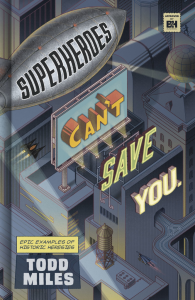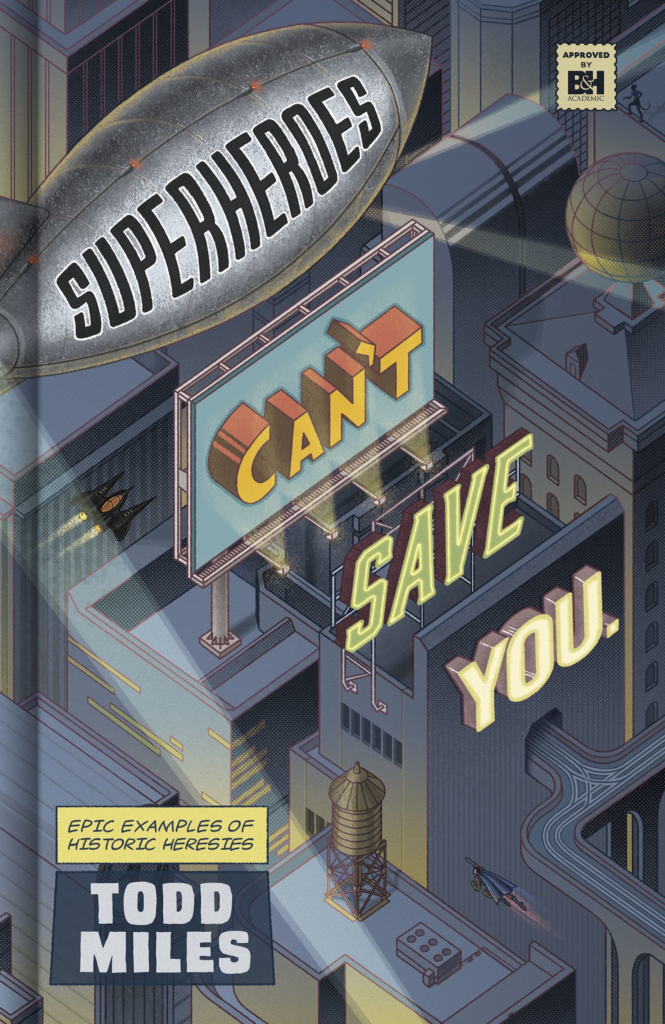Miles, Todd. Superheroes Can’t Save You: Epic Examples of Historic Heresies. Nashville: B&H 2019. pp. 208, $20 paperback.
Todd L. Miles is professor of Theology and Director of the Master of Theology program at Western Seminary in Portland, OR.
We are easily enamored with escaping our normal everyday lives to enjoy watching our favorite superhero destroy the evil villain, bring justice to the oppressors, and save the day. Whether you are a Marvel or DC fanatic, most people cannot resist seeing the newest superhero movie that seems to drop every few months. The connection and love we have with superheroes seem to highlight a deeper truth that as humans, we all desire someone who is more powerful and stronger than us to come and save us from the difficulties and sufferings in our lives. All superheroes are attempts to create a “savior-like figure” who can rescue us from our depravity using their super-human powers. Yet as Todd Miles demonstrates in his book, Superheroes Can’t Save You, every superhero that we have created is an inadequate picture of the true hero of the story of reality: Jesus Christ.
Superheroes Can’t Save You attempts to show how each one of our coveted heroes exhibits a “bad idea about Jesus,” that can be traced back to the heresies that arose in the early church about the person of Christ. It is important to understand these heresies because these “bad ideas” undercut the gospel and can lead others away from embracing the true gospel. Therefore, each chapter of the book provides an explanation of a superhero; how each superhero displays an incomplete view of Jesus; and how Jesus is a much better idea than what is represented by each superhero (p. 7). Each chapter is divided up into five sections: an introduction of the superhero, the heresy that the superhero represents, how this heresy is still practiced today, what the Bible teaches to combat this heresy, and why these truths about Jesus are important for our lives today.
Miles covers most of the heresies about the person of Christ from the early church, which include Docetism, Modalism, Arianism, Adoptionism, Apollinarianism, Nestorianism, and Eutychianism. The only heresy that Miles covers that cannot not be traced back to the early church is Liberalism, which he argues, was birthed in the 18th century by Friedrich Schleiermacher. Due to its focus on the heresies of Christ and the four famous councils of the early church, Superheroes Can’t Save You aids in adding to the reader’s understanding of the church history and Christology of the Patristics. The book is written to students in theological studies but can also be understood by the general Christian or skeptic who has an interest in learning more about the person and work of Jesus.
Four commendable aspects of the book can be seen in the readability of the prose, the relatability to understanding how each heresy is represented by a familiar symbol of a superhero, the linear progression of the author’s thought, and the practical application and discussion questions at the end of each chapter. Throughout the book, Miles uses big theological terms but always defines and provides helpful examples to further the reader’s understanding. One example can be seen when Miles explains how to understand Nestorianism through the character Gollum from The Lord of the Rings. Just as Nestorius believed Jesus had two natures and two separate consciousnesses, Gollum provides a practical example that most readers can relate to in his split personality with his other personhood of Smeagol.
Another example can be seen by each of the sub-headings of the chapters. Miles provides a short statement that describes each heresy in a way that is embodied by the superhero that is the subject of each chapter. For example, Docetism is described as thinking Jesus was simply “God in disguise” just as Superman disguised himself as a man in Clark Kent. The complexities of Eutychianism can be arduous to comprehend for most people, but relating this heresy to Spider-Man, knowing Peter Parker is part human and part Spider, is much easier for the reader to understand Eutyches’ claim that Jesus had a hybrid nature in being part human and part god.
The similarity of the structure and organization of each chapter allows the reader to easily understand Miles’ argument and flow of thought throughout the work. The framework of each argument also helps teach readers how to approach, understand, and combat false ideas that undercut the gospel. For example, Miles starts each chapter laying the background information by describing the superhero, how they emulate the heresy, and then the historical information of what the heresy is and how it originated. Once a charitable explanation of the heresy is given, he expounds on how we can still believe this false idea today and how it leaves a picture of Jesus that cannot save us. Miles then confronts the false idea with the truth of God’s Word; and demonstrates who the Bible proclaims Jesus to truly be; and then concludes with why believing these truths about Jesus are important for our lives today. This structure demonstrates the necessity of conducting sound historical research and biblical exegesis to demolish strongholds or any lofty thought that is raised up against the knowledge of God.
Lastly, the personal application sections and discussion questions are what make this book a user-friendly and a practical resource. When considering ideas that were espoused in the third and fourth centuries, readers can easily revert into thinking these ideas have nothing to do with them today. Yet, Miles provides everyday examples of how we can still fall into these heresies. For example, when looking at Modalism, most Christians understand the common fallacy of comparing the Trinity to H2O or a three-leaf clover, but very few realize they are falling into Modalism during prayer when they ascribe to the Father things that only the Son did (i.e. dying on the cross, Patripassianism). Miles then explains how having these false ideas about Jesus can have serious consequences. Using the Modalism example, if Jesus is just “one of three costumes God put on,” then he cannot answer our prayers because the Bible teaches us to pray in a trinitarian way of praying to the Father, in the name of the Son, and through the Holy Spirit. More importantly, this view of Jesus cannot save us because it was the work of all three persons of the Trinity that was necessary to accomplish our salvation. To drive the application further for the reader, Miles ends every chapter with personal reflection questions, small group discussion questions, and a section for further study to foster deeper application and life transformation by meditating on the timeless truths about Jesus.
One critique of the book is the lack of scholarly contributions. There are few, if any, footnotes and there is no bibliography section. In Miles’s defense, it does not appear that a scholarly and in-depth magnum opus of the heresies of church history and a thorough exegesis of Christology was his intention in writing this book. Rather in this work, Miles seeks to provide a practical resource for students of theology, youth workers, and avid superhero fanatics that provides sound historical theology, biblical exegesis, and Christology in an easy-to-read format and everyday language. Miles’s creativity should be extolled in the way he exquisitely expounds how each heresy is emulated by superheroes that are easy to relate to and remember. Therefore, this book is for any Christian or skeptic who wants to take a deeper dive in understanding the false ideas about Jesus that are still being propagated today and how the Bible confronts those lies to demonstrate who Jesus truly is: two natures, one person, fully God, fully human. Superheroes can’t save us, but praise God that Jesus can!
Andrew Slay
PhD Student
New Orleans Baptist Theological Seminary





